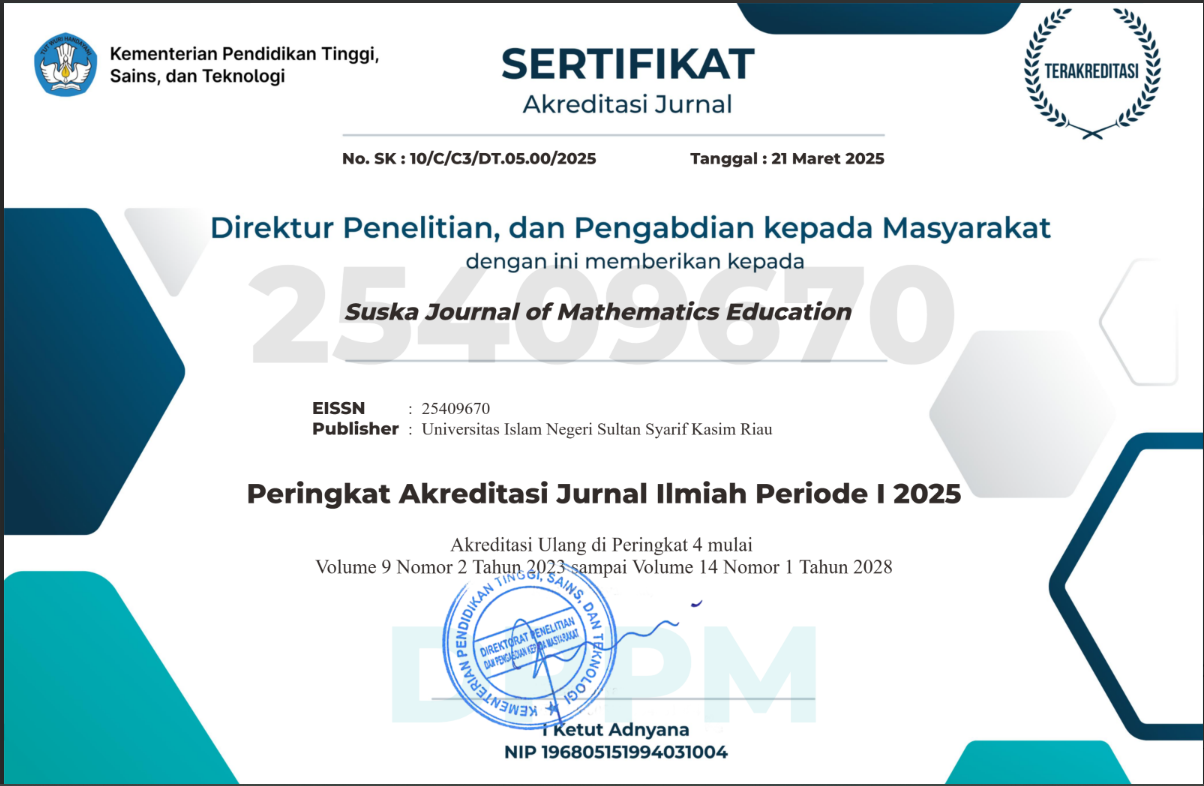Hubungan antara Mathematics Teaching Efficacy Beliefs dan Mathematics Teaching Anxiety Mahasiswa PPL Program Studi Pendidikan Matematika
Abstract
Keywords
Full Text:
PDFReferences
Albayrak, M., Unal, Z. A. (2011). The Effect of Methods of Teaching Mathematics Teaching Efficacy Beliefs f Elementary Pre-service Mathematics Teachers. International Journal of Humanities and Social Science, 1(16), 183-190
American Psychiatric Association. (2013). Diagnostic and Statistical Manual of Mental Disorder (Fift ed.) Arlington, VA: American Psychiatric Publishing. P. 189.
Atkinson, R. L., Atkinson, R. C., & Hilgard, E. R. (1999). Pengantar Psikologi (Ed. 8). Jilid 2. Jakarta: Penerbit Erlangga
Astuti, N. W., Suhandana, I. G. A., & Dantes, N. (2013). Studi Evaluasi Efektivitas pelaksanaan Praktik Pengalaman Lapangan (PPL) Mahasiswa Fakultas Pendidikan dan Kesehatan (FPOK) IKIP PGRI Bali tahun 2012. E-Journal ProgramPascasarjana Universitas Pendidikan Ganesha, 4(1), 1-12.
Azwar, S. (2000). Sikap Manusia: Teori dan Pengukurannya (Edisi Pertama). Yogyakarta: Pusraka Pelajar Offset.
Behers. D. (I990). Concerns of Preservice Physical Education Teachers. Journal of Teaching in Physical Education, 10(1974), 66-75.
Bouras, N., & Holt. G. (2007). Psychiatric and Behavioral Disorders in Intellectual and Developmental Disabilities (2nd ed.). Cambridge: Cambridge University Press
Bradley, R. C. (1984). Taking Stress Out of Student Teaching. The Cleaning House. 58. 18-21.
Capel, S. A. (1997). Changes in Students' Anxieties and Concerns after Their First and Second Teaching Practice. Educational Research, 39, 211-228.
Catlioglu, H., Birgin, O., Costu, S., & Gurbuz, R. (2009). The level of Mathematics Anxiety among Pre-service Elementary School Teachers. Procedia Social and Behavioral Sciences , 1, 1578-1581, doi:10.1016j .sbspro.2009.01.277
Ennis-cole, D. L. (n.d.). Emerging Theories of Learning and Preservice Teachers. Retrieved from http:courses.unt eduF,nnis-Colearticlesa26.pdf
Enoch, L. G., Smith, P. L., & Huinker, D. (2000). Establishing Factorial of The Mathematics Teaching Efficacy Beliefs Instrument. School Science and Mathematics, 100, 194-202.
Ertekin, E., Dilmac, B., Yazici, E., Peker, M. (2010). The Relationship between Epistemological Beliefs and Teaching Anxiety in Mathematics. Educational Research and Review. 5(October), 631-636
Fontana, D., Abouserie, R. (1993). Stress levels, gender and personality factors in teachers. British Journal of Educational Psychology, 63, 261-270
Frost, J. B. and D. (2012). Education International Research Institute. Retrieved from http://download.ei-ie.org/Docs/WebDepot/teacher_self_efficacy_voice_eadership.pdf
Furner. J. M.. Gonzalez-dehass. A. (2011). How do Students' Mastery and Performance Goals Relate to Math Anxiety? Eurasia Journal of Afathematics. Science Technology Education, 7(4), 227-242.
Hadi. S. (2000). Methodology Research Jilid 1-4). Yogyakarta: Yayasan Penerbit Fakultas Psikologi Universitas Gadjah Mada.
Hart. N. 1. (1987). Student Teachers' Anieties: four measured factors and their relationship to pupil disruption in class. Educational Research, 29(1), 12.
Hembree. R. (1990). The Eature, Effect. and Relief of Mathematics Anxiety. Research in Mathematics Education, 21(1), 33-46.
Mcbride, R. E. (1981). Perceived Teaching and Program Concerns Among Preservice Teachers, University Supervisors, and Cooperating Teachers. Journal of Teaching in Physical Education, 3, 36-43.
Moleong, L. J. (2004). Metodologi Penelitian Kualitatif. Bandung: PT. Remaja Rosdakarva,
Morton, L. L., Vesco, R., Williams, N. H., Awender, M. A. (1997). Student Teacher Anxieties Related to Class Management, Pedagogy, Evaluation, and staff Relations. British Journal of Educational Psycholology, 67, 69-89.
Ngidi, D. P., & Sibaya, P. T. (2003). Student Teacher Anxieties Related to Practice Teaching. South African Journal of Education, 23(1), 18-22.
Peker, M., & Ertekin, E. (2011). The Relationship between Mathematics Teaching Anxiety and Mathematical Anxiety. The New Educational Review, 23(1), 213-226.
Peker, M., Halat, E., Mirasyedioglu, S. (2010). Gender Related Differences in Mathematics Teaching Anxiety. The Mathematics Educator, 12(2), 125-140.
Preece, P. P. W. (1979). Student Teacher Anxiety and Class-Control Problems on Teaching Practice: a Cross-lagged Panel Analysis. British Educational Research Journal, 5(1), 13-19.
Singarimbun, M., Effendi, S. (1996). Metode Penelitian Survey. Jakarta: Pustaka LP3ES
Spangler. D. A. (1990). Assessing Students' Beliefs About Mathematics. The Mathematics Educator. 3(1), 19-23.
Sugiyono. (2007). Metode Penelitian Pendidikan Pendekatan Kuantitatif, Kualitatif dan RD. Bandung: CV Alfabeta.
Sugiyono. (2010) Metode Penelitian Pendidikan Pendekatan Kuantitatif, Kualitatif dan RD. Bandung: CVAlfabeta
Suinn, R. M., Winston, E. H. (2003). The mathematics anxiety rating scale, a brief version: Psychometric data. Psychological Reports, 92(1), 167-173
Sullivan, L. (2006). Guided Imagery's Effects on the Mathematics Teaching Efficacy of Elementary Preservice Teachers. University of New Orleans
Trujillo, K. M., Hadfield, O. D. (1999). Tracing the Roots of Mathematics Anxiety Through in-depth Interviews with Preservice Elementary Teachers. College Student Journal, 33(2), 219-232
Vinson, B. M. (2001). A Comparison of Preservice Teachers' Mathematics Anxiety Before and After a Methods Class Emphasizing Manipulatives. Early Childhood Education Journal, 29(2), 9-94
Wendt, J. C., Bain, L. L. (1989). Concerns of Preservice and Inservice Physical Educators. Journal of Teaching in Physical Education, 8, 177-180
DOI: http://dx.doi.org/10.24014/sjme.v5i1.7469
Refbacks
- There are currently no refbacks.

This work is licensed under a Creative Commons Attribution-NonCommercial-ShareAlike 4.0 International License.
Published by:

FLAG COUNTER





